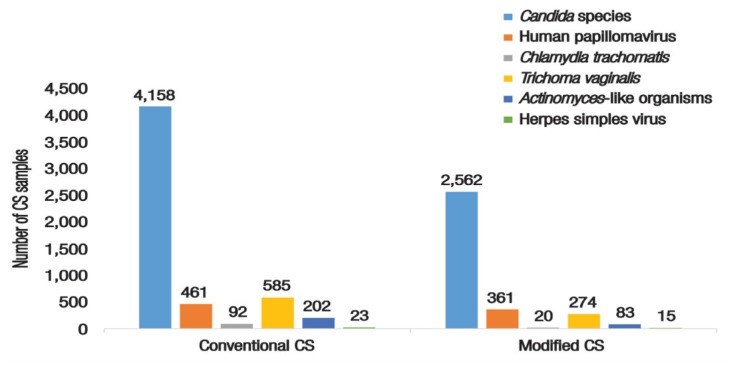Prevalence of Infectious Organisms Observed in Cervical Smears Between 1997-2014 at Mubarak Al-Kabeer Hospital, Kuwait
Affiliations
Affiliations
- Department of Medical Laboratory Sciences, Faculty of Allied Health Sciences, Kuwait University, Kuwait.
- Cytology Laboratory, Mubarak Al-Kabeer Hospital, Kuwait.
- Department of Pathology, Faculty of Medicine, Kuwait University, Kuwait.
- Department of Research & Biostatistics Unit, Faculty of Medicine, Kuwait University, Kuwait
Abstract
Objectives: This study aimed to examine gynaecological infectious agents observed in conventional and modified Papanicolaou cervical smears (CS) at a tertiary care hospital in Kuwait.
Methods: This retrospective study analysed 121,443 satisfactory CS samples collected between 1997-2014 at the Mubarak Al-Kabeer Hospital, Kuwait. Conventional CS samples were obtained between 1997-2005, while modified CS were obtained between 2006-2014 following the introduction of ThinPrep® testing (Hologic Corp., Bedford, Massachusetts, USA). All samples were initially screened by cytoscreeners before being analysed by cytopathologists to determine the presence of specific infectious agents.
Results: Overall, 8,836 (7.28%) of the cervical samples had infectious agents; of these, 62.48% were conventional and 37.52% were modified CS samples. The most frequently observed infectious agents were Candida species (76.05%), Trichomonas vaginalis (9.72%), human papillomavirus (HPV; 9.3%), Actinomyces-like organisms (3.23%), Chlamydia trachomatis (1.27%) and the herpes simplex virus (HSV; 0.43%). There were significantly more cases of Candida species, HPV-associated changes, C. trachomatis, T. vaginalis and Actinomyces-like organisms detected in conventional compared to modified CS samples (P <0.050 each). However, there was no statistically significant difference in the frequency of HSV-associated changes (P = 0.938). The presence of two infectious agents in the same sample was identified in 0.87% of samples.
Conclusion: Among CS samples collected during an 18-year period, Candida species were most frequently detected, followed by T. vaginalis and HPV. The identification of potential infectious agents is a valuable additional benefit of Papanicolaou smear testing.
Keywords: Candida; Cervical Smears; Cytology; Human Papilloma Virus; Infection; Kuwait; Papanicolaou Test; Trichomonas vaginalis.
Conflict of interest statement
CONFLICT OF INTEREST The authors declare no conflicts of interest.
Figures
Similar articles
Gynecologic infections seen in cervical smears in Kuwait.
Al-Awadhi R, Al-Ramadan BA, George SS, Sharma PN, Kapila K.Acta Cytol. 2010 Jan-Feb;54(1):50-4. doi: 10.1159/000324966.PMID: 20306988
Haltas H, Bayrak R, Yenidunya S.Ginekol Pol. 2012 Oct;83(10):744-8.PMID: 23383559
Güdücü N, Gönenç G, Işçi H, Yiğiter AB, Başsüllü N, Dünder I.Clin Exp Obstet Gynecol. 2012;39(3):333-6.PMID: 23157037
Zemouri C, Wi TE, Kiarie J, Seuc A, Mogasale V, Latif A, Broutet N.PLoS One. 2016 Oct 5;11(10):e0163365. doi: 10.1371/journal.pone.0163365. eCollection 2016.PMID: 27706174 Free PMC article. Review.
Caruso CR, Yang Z.Diagn Cytopathol. 2023 Jan;51(1):68-82. doi: 10.1002/dc.25064. Epub 2022 Oct 20.PMID: 36263664 Review.
